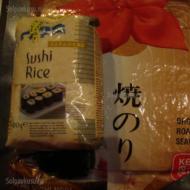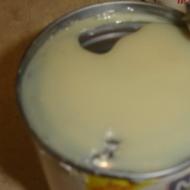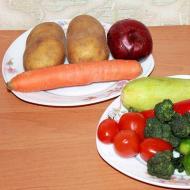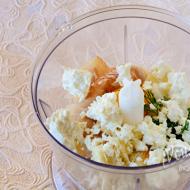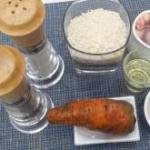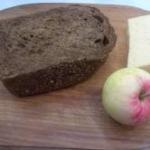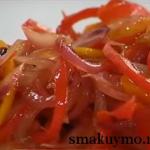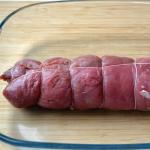
Wine from vegetables at home. Who drunk Roger Rabbit, or homemade wine from carrots according to science. Carrot wine: all the benefits in the drink
Not many lovers of home winemaking will come up with the idea of making wine from vegetables. If you still decide to try to make such a drink at home, then I must say that you are a real connoisseur and master of making wine. Alcoholic beverages based on vegetable crops are not very common. There are several reasons for this.
vegetable fantasies
In order to prepare vegetable wines, it is necessary to have a sufficiently large crop of these crops. After all, carrots and beets are grown for cooking. It happens that it is not possible to eat all the root crops stored for the winter. This is how beetroot wine and carrot wine appeared on our table.
 There are several recipes for these drinks. Both on the basis of raw juice and infusion on boiled vegetables. Here already everyone is determined with priorities himself. Raw juices ferment faster, give a higher degree. Based on boiled root crops, drinks are obtained with a more delicate taste.
There are several recipes for these drinks. Both on the basis of raw juice and infusion on boiled vegetables. Here already everyone is determined with priorities himself. Raw juices ferment faster, give a higher degree. Based on boiled root crops, drinks are obtained with a more delicate taste.
Wines from root vegetables have a rich color due to the high content of natural carotenoids, especially in carrots.
Beetroot gives the drink a maroon color, which is difficult to achieve when making wine, even from grapes.
Everyone knows the beneficial properties of beets and carrots: they contain vitamins, trace elements, minerals, antioxidants, natural carcinogens. Pectic substances of root vegetables help the body fight toxins. Carrot's natural carotene pigments make our skin soft and silky. Beetroot antioxidants remove excess fluid from the body, have a choleretic effect.
Features of beetroot wine
 I must say that since vegetables are still not the main raw material for making wine, they do not contain natural fermentation catalysts. Therefore, the preparation of wines necessarily requires making them additionally. At the same time, only yeast is used, no other stimulants are suitable. The content of tannins and antimicrobial substances in the original product is too high.
I must say that since vegetables are still not the main raw material for making wine, they do not contain natural fermentation catalysts. Therefore, the preparation of wines necessarily requires making them additionally. At the same time, only yeast is used, no other stimulants are suitable. The content of tannins and antimicrobial substances in the original product is too high.
Before you start making wine from beets, the raw materials must be carefully processed. Since beets and carrots are root crops, it means that, first of all, they need to be thoroughly washed from the ground. First, the vegetables are soaked in cold water, then washed with running water using a brush, then scalded with boiling water. If you neglect the thoroughness of processing, then you can bring earthen mold into the wine and all efforts will be in vain. Before preparing a drink from boiled vegetables, they are cut into pieces along with the peel, without peeling.
If the preparation of wine will be from juice, then after processing fresh vegetables, it must be squeezed out on a juicer. Then you should clean the root crops from the top crust.
Recipe with Lemon and Orange
Required for cooking:

How to prepare wine:

According to the same recipe, you can make carrot wine, you can mix these vegetables in equal proportions or to taste. The result will be good.
The wine is rich, deep color with aromas of spices, with a taste of citrus. Great for making punch or mulled wine.
Conclusion
A generous autumn harvest of carrots and beets can bring joy not only from the preparation of traditional dishes, but also become an incentive for the manifestation of imagination in the preparation of wines and various alcoholic beverages based on them.
Light alcohol with a characteristic carrot aroma and subtle notes of citrus (if you add lemon juice and orange). Like other vegetable wines, the taste is specific, for an amateur, but it's worth a try at least once.
To make wine, ripe and juicy carrots are required without rotten, spoiled and moldy parts. When storing for a long time, you need to check if the vegetables have a characteristic earthy or musty smell that will be transferred to the wine.
To prevent infection with pathogenic microorganisms, before starting cooking, all tools and containers used must be sterilized with boiling water, then wiped dry.
Ingredients:
- carrots - 3.5 kg;
- water - 6 liters;
- lemon - 1 piece or 6-7 grams of citric acid per 1 liter of must;
- sugar - 250 grams per 1 liter of must;
- orange - 1 piece (optional);
- homemade raisin sourdough or wine yeast - for 8 liters of must.
Lemon juice or acid is needed to stabilize the acidity of the must, otherwise the fermentation of carrot wine will be weak and the taste slurred. Lemon juice is preferred as it enhances the flavor. Orange enriches the taste with light citrus tones.
Attention! If, instead of sourdough or wine yeast, you add ordinary dry or bakery yeast, then instead of wine you get mash with characteristic alcohol tones and a sharp taste.
carrot wine recipe
1. If there is no wine yeast, 4-5 days of work with carrots from unwashed raisins or fresh berries. Sourdough is activated "wild" wine yeast that is found on the surface of the fruit.
2. Wash and peel the carrots, grate on the smallest grater. If you leave the peel, bitterness may appear.
3. Put the resulting pulp into a saucepan, pour boiling water over it, mix and cover. Leave for a day.
4. Filter the carrot must through cheesecloth. Press the cake to dryness (no longer needed).
5. In the liquid part, add 150 grams of sugar per 1 liter of juice, all the required citric acid or juice of squeezed lemons, orange juice. Add starter (without berries) or wine yeast activated according to the instructions on the bag. Mix.
6. Pour the wort into the fermentation vessel, filling no more than 75% of the volume, so that there is room for new portions of sugar, carbon dioxide and foam. Install a water seal of any design on the neck (you can use a medical glove with a pierced hole in one of the fingers).
 Conventional water seal with tube
Conventional water seal with tube  Sterile glove instead of a water seal
Sterile glove instead of a water seal 7. Move the container to a dark room with a stable temperature of 18-28 °C. Leave until the end of fermentation.
5 days after installing the water seal, add the next portion of sugar - 50 grams per 1 liter. To do this, pour about 50% of the juice from the added sugar into a separate container, for example, if you need to add 3 kg, then 1.5 liters of juice is required. Dilute the sugar in the juice, pour the resulting syrup back into the fermentation tank and close it again with a water seal.
After another 5 days, add the remaining sugar (50 grams per 1 liter) according to the described technology.
Depending on the temperature and yeast, carrot wine ferments for 30-60 days, then the water seal stops releasing gas (the glove deflates), a layer of sediment appears at the bottom, and the wine itself becomes noticeably lighter.
If fermentation does not stop after 55 days after adding the first portion of sugar, you need to drain the wine from the sediment through a tube into another container, then put it under a water seal to ferment at the same temperature, otherwise bitterness may appear.
8. Remove fermented young wine from the sediment by pouring through a straw. Taste the drink. If desired, additionally sweeten with sugar and (or) fix with alcohol (vodka) in an amount of 2-15% of the volume. Fixing promotes long-term storage, but hardens the taste.
9. Pour the wine into aging containers, making sure to fill up to the neck to minimize contact with air. Seal tightly (if sugar was added, keep under a water seal for the first 7-10 days).
10. Transfer carrot wine for aging to a refrigerator or cellar with a temperature of 6-16 °C. Leave at least 5-6 months (preferably 8-9).
11. When a sediment 3-5 cm thick appears, filter the drink by pouring without touching the sediment at the bottom. Usually 3-4 filtrations are required.
12. Wine is considered ready when the sediment does not appear for more than a month. The drink can be bottled and hermetically sealed with corks.
 The shade of wine depends on carrots and aging
The shade of wine depends on carrots and aging Shelf life in the basement or refrigerator - up to 3 years. Fortress - 11-14%.
We bring to your attention a selection of recipes for making homemade wine from vegetables.
You will not surprise anyone with jam from green tomatoes, eggplant or zucchini. But you can surprise your family and guests with vegetable wine. True, it is not building to try to make sweet wines from vegetables; dry wines are best made from them.
carrot wine
- 2 kg carrots
- 4 liters of boiling water,
- for 4.5 liters of juice - 4-5 glasses of sugar,
- 1 st. l. yeast,
- juice of 1 lemon,
- juice of 1 orange,
- 1 cracker.
Recipe:
Wash and cut the carrots into slices, pour boiling water. Let stand 4 days. Measure the amount of juice, add sugar, lemon and orange juice and yeast spread on breadcrumbs. Put in a warm place (18-24 ° C) for fermentation. After the end of fermentation, mix well, let stand for 3 days. Then strain, pour into a barrel and leave for 8-9 months, then bottle, cork them and store in a dark cool place.
Zucchini wine (dry white wine)
- 1 kg zucchini
- 1.5 liters of boiling water
- 10-20 g ginger
Recipe:
Cut the zucchini into pieces, add fresh ginger and pour boiling water over it. Leave to infuse for 6 days under pressure. Increase the pressure of the press every day. Strain the juice after 6 days. Determine its volume, add the required amount of sugar, lemon juice and yeast. Leave in a warm place (temperature approximately + 20-25 ° C) for fermentation. When bubbling stops, stir. Let stand for another 3 days until the sediment settles to the bottom.
Strain and pour into a barrel. Cork and leave for six months, then bottle.
Beet wine ("beetroot port")
- 1 kg beets
- 1.5 liters of water
- 30 g ginger,
- for 2.5 liters of juice - 2 cups of sugar, 1 teaspoon of yeast, juice of 1 lemon.
Recipe:
Wash and cut the beets into slices. Pour boiling water over it and add ginger. Leave for 4 days. After measuring the amount of juice, add sugar, yeast and lemon juice, leave in a warm place to ferment. After the end of fermentation, stir and leave for 3 days until it settles.
Strain and pour into a barrel, leave for 8-10 months. After that, bottle, seal and store in a dark, cool place.
Tomato wine (rosé wine)
- 4 kg tomatoes
- 4 cups sugar
- 2 lemons
- a pinch of salt
- 1 st. l. yeast.
Recipe:
Cut the tomatoes, sprinkle with salt, pour 1200 ml of boiling water. Leave for 4 days using oppression. Strain, add sugar, yeast and lemon juice to the juice. Put in a warm place to ferment. When fermentation is over, add cold boiled water to the container, cork and place in a dark, cool place.
Hold for 3 weeks, then drain the wine without sediment into another cask. Cork and leave in a cool place for another 1.5 months.
After that, pour the wine from the tomatoes into bottles, cork and keep in a cool place.
Potato wine (dry white wine)
- 5 kg potatoes
- 30 g white cream of tartar
- 10-20 g ginger
- 150 g raisins
- 2 lemons
- 70 g wine yeast.
Recipe:
Boil 4 buckets of water, put raisins in the water and cook for half an hour. Then grate potatoes and put in water with raisins. Also add finely ground cream of tartar. Strain the liquid into a clean wooden barrel. Let cool to 15°C.
Add fresh white wine yeast, finely crushed ginger. Chop the lemons and add to the mixture as well.
Do not change the room temperature until the fermentation process is over. After the end of fermentation, add cold boiled water to the barrel, cork and put in the cellar. Leave the cask in the cellar for 3 weeks, then drain the wine into another cask, cork and place in the cellar. Leave the barrel for 1.5 months, then bottle the wine.
The finished product is somewhat reminiscent of dry sherry. The shade of carrot wine is juicy, sunny, close to honey or amber. This wine will decorate a family meal and will be in place on the festive table. The taste is soft, light, with a specific carrot aroma.
- When selecting raw materials, ripe, strong root crops should be preferred, without signs of rot, mold, musty, earthy smell.
- It is best to make wine from a fresh crop of late carrot varieties harvested no earlier than October.
- It is recommended to include citrus fruits in the composition of the ingredients: they will soften the sharp vegetable flavor and make the drink brighter and more aromatic.
- The quality of the finished wine improves markedly with increasing shelf life.
Classic Carrot Wine Recipe
The pectin enzyme is needed to clarify the drink. If it is not there, you can clean the wine from impurities using one of the popular methods: protein, gelatin, etc.
Ingredients
- Carrots - 5-6 kg
- Light raisins - ½ kg
- Sugar - 2.8-3.2 kg
- Pectin enzyme - 1 tsp.
- Water - 8 l
- Dry black tea - 3 tsp.
- Wine yeast - 1 sachet
- Citric acid - 1 tbsp. l.
Cooking Method
- Wash the fruits thoroughly, without removing the skin, cut into medium-sized cubes.
- Put the carrot mass in a container with water, boil, boil over low heat for 15-20 minutes.
- Cut the raisins, pour into a glass vessel, add sugar to it, pour hot vegetable broth, mix well, let cool.
- Pour tea with a glass of boiling water, wait for cooling, pour into carrot mixture, introduce pectin enzyme and yeast nutrition.
- Seal the container with a lid and leave to infuse overnight.
- Pour yeast into the infusion, cover the vessel with a clean tissue flap, transfer to the dark for 1-1.5 weeks, shake the contents daily.
- After the decline of active fermentation processes, carefully pour the wine into a large clean container, strain (if desired, add water to a 10-liter volume).
- Put a water seal, transfer to the dark until the end of the fermentation processes, monthly removing the drink from the sediment.
- Distribute the finished wine in small vessels, seal, keep in the cold for at least 1 year.
Carrot Citrus Recipe
The drink is obtained with a soft orange-golden color. The taste, thanks to citrus fruits, softens and acquires a slight bitterness.
If you want to increase the piquancy, instead of squeezing the juice, the orange should be cut into slices and added to the rest of the ingredients.
It is not necessary to remove the skin from the carrots, but it is desirable: it can add a sharp flavor to the wine.
Instead of solid yeast, you can take special wine (1 bag) or raisin sourdough.
Ingredients
- Carrots - 2 kg
- Water - 4 l
- Sugar - 4-5 cups
- Orange - 1 pc.
- Lemon - 1 pc.
- Rye cracker - 1 pc.
- Solid yeast - 1 tbsp. l.
Cooking Method
- Wash vegetables, finely chop or grate, put in a clean container.
- Boil the water, pour it over the carrot mass.
- Cover the container with a gauze cloth, let the mixture soak for 3-4 days.
- Pour the infusion into a suitable vessel, add sugar, squeeze citrus juice into it.
- Spread the yeast on the cracker, throw in the carrot mixture.
- Put a water seal on the bottle and put the wort in heat.
- At the end of fermentation processes (after 1–2 months), pass the drink through the filter, pour into a clean container, cork, place in cold and dark for 8–9 months.
- Pour the drink into small containers, keep cool.
Carrot banana wine
Ingredients
- Carrots - 4.5 kg
- Raisins - 1.7 kg
- Sugar - 1.7 kg
- Lemon - 2 pcs.
- Banana - 4 pcs.
- Orange - 4 pcs.
- Freshly brewed black tea - 1 cup
- Pectin enzyme - 1 tsp.
- Top dressing for yeast - 2 tsp.
- Water - 8–9 l
- Wine yeast - 1 pack
Cooking Method
- Carefully washed carrots cut into circles and cubes, put in a saucepan.
- Pour the vegetable mass with water (6 l), boil over low heat for a quarter of an hour.
- Drain the broth into a bottle, add sugar, squeeze citrus juice into it.
- Grind bananas and raisins, add to the carrot mixture.
- Pour in yeast top dressing, pour in strong tea and the remaining water (2–3 l).
- Wait for the liquid to cool (to a warm state), introduce yeast and pectin enzyme.
- Cover the container with a clean cloth, put it in the dark and warm for 5 days, stir daily.
- Drain the infusion into a clean vessel, squeeze out the mass, discard the cake, put the shutter and keep at room conditions until active fermentation stops.
- Drain the drink from the sediment, pour it into a new container, install the shutter, take it to a cool corner, wait 60-90 days, removing it from the sediment once a month.
- Place the wine in small bottles, keep in the cold for at least 1 year before tasting.
Carrot-grain wine with citrus aroma
This product is otherwise called carrot whiskey because of the noble amber-golden color and rich rich taste. For full maturation, the finished wine is recommended to be stored for at least 1 year in a cool place; additional aging will only benefit the drink.
Ingredients
- Carrots - 7.5 kg
- Fine sugar - 4 kg
- Orange - 5 pcs.
- Wheat grains - 1 kg
- Raisins - 3 tbsp. l.
- Lemon - 5 pcs.
- Water - 8–9 l
- Wine yeast - 1 sachet
Cooking Method
- Wash and grate the carrot without removing the skin.
- Pour the vegetable mass into a large saucepan with water, boil and boil over low heat for about half an hour.
- Cut the fruit into small slices, put in a large glass container, pour half the sugar there.
- Pour the carrot broth into the citrus-sugar mixture, after squeezing and removing the cake through cheesecloth.
- Mix the resulting mass well, let it cool slightly, add wheat and chopped raisins, add yeast.
- Cover the vessel with a tissue flap, transfer to heat and darkness for 6 days, shake the mixture twice a day.
- Pour half of the remaining sugar into the infusion, mix well.
- Wait another 1 week, remembering to stir the wort daily.
- Enter the rest of the sugar, leave to ferment for another 1.5 weeks, shaking the mixture regularly.
- After the expiration date, strain the infusion into a clean container, removing the sediment, put the shutter and send it to a dark, cool corner.
- After 1 month, remove the liquid from the sediment and hold for another 30 days in the cold.
- Separate the sediment again and pour the finished drink into a small glass container.
Found a bug or have something to add? Highlight the text and press CTRL + ENTER or . Thank you for your contribution to the development of the site!
It is unlikely that the recipe for making wine from carrots is known to many users and connoisseurs of high-quality alcoholic beverages. Most often, other common products and ingredients are used as the basis for making wine. But those who have tried carrot wine at least once will forever remember its original taste, softness and amazing aroma.
To make wine from carrots at home, you need ripe and juicy carrots that do not show signs of mold or rot. If before that the fruits were stored for a long time in the cellar or basement, then it is necessary to check whether they have absorbed a specific earthy smell, which will certainly be transferred to the finished drink.
In order to avoid contamination of wine with pathogenic microorganisms, it is important that all containers used in preparation are thoroughly washed and sterilized, and also wiped dry.
Carrot wine recipe - we implement the original recipe
In order for carrot wine to be prepared by anyone, even a novice winemaker, the following ingredients will be needed:
- Carrots - 3.5 kg;
- Drinking purified water - 6 l;
- Lemon - 1 piece or 6-7 g per 1 liter of must;
- Sugar - 250 g per 1 liter of must;
- Orange - 1 pc;
- Raisin starter or wine yeast - calculate for 8 liters of must.
Citric acid or fresh fruit juice is necessary to stabilize the acidity of the must, because otherwise the wine fermentation process will be slow and inefficient, and the taste of the finished drink will be weak. Thanks to the orange, the taste of the finished wine is enriched with citrus tones.

The technology for making wine from carrots consists of the following steps:
- 4-5 days before the start of the cooking process, it is necessary to make a starter from fresh berries or unwashed raisins by activating wine yeast;
- Carrot fruits are washed, peeled and rubbed on the smallest grater. The peel must be cut off, because it will bring notes of bitterness to the finished drink;
- The resulting pulp is put in a saucepan and poured with boiling water, after which it is thoroughly mixed and covered with a tight lid;
- The container is placed in a dark place for a period of 24 hours;
- Carrot must is passed through several layers of gauze, and the cake is carefully squeezed out, and then thrown away;
- 150 g of granulated sugar is added to the liquid part of the wort per 1 liter of it. After that add citric acid and orange juice. Leaven or activated yeast is also added to the wort and mixed thoroughly;
- The wort is poured into a fermentation container, a water seal is installed on its neck, which can be successfully replaced with an ordinary medical glove, with a hole pierced in one of the fingers;
- The container is placed in a dark place with a stable temperature for fermentation;
- 5 days after the water seal was installed, the next part of sugar is added at the rate of 50 g per 1 liter. To do this, about 50% of the juice is drained, sugar is diluted in it and poured back again. After 5 days, the procedure is repeated;
- As a rule, carrot wine ferments for 1-2 months, after which the wine stops emitting carbon dioxide and acquires a light shade;
- Fermented young wine is drained from the sediment through a thin tube so as not to touch the sediment. At the request of the home craftsman, the drink can be sweetened or fixed with an alcohol base;
- The wine is poured into an aging vessel in such a way that it is filled to the brim and there is no contact with oxygen;
- Wine containers are hermetically sealed and placed in a cellar or refrigerator for a period of six months or more;
- If sediment appears at the bottom of the container, then it must be poured into another, leaving the sediment at the bottom;
- The wine is considered fully cooked and ready to drink when sediment at the bottom has not appeared within 1 month;
- The drink is bottled, sealed tightly and stored in a cool place such as a basement or refrigerator.
The shelf life of the finished wine is up to 3 years, and the strength is from 11 to 14%.



